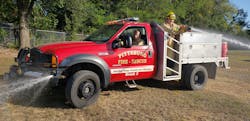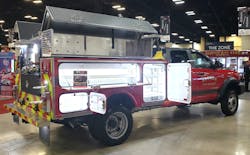Ask a dozen firefighters who have a few active fire seasons under their belt about the best design for a wildland fire apparatus and you probably will get 12 different recommendations. The fact is, practically every geographic location has unique requirements for its apparatus.
Texas has one of the most diverse environments that’s found anywhere. There are 10 climatic regions, 14 soil regions and 13 ecological regions. There are so many variances in terrain and vegetation that Texas has 14 unique Predictive Service Areas to provide short- and long-term wildfire weather and behavior forecasts and analysis.
Elevation in the state ranges from sea level to more than 8,500 feet. The state has a land mass of 268,581 square miles and 367 miles of coastline. The second largest canyon in the nation is in Texas. Desert regions in southwest Texas receive fewer than 12 inches of annual rainfall, yet there are inland swamps in the southeastern part of the state. More than 63 million acres of forests and woodlands make the state the tenth-largest timber producer in the nation.
Primary rig considerations
The Type 6 engine is the bread-and-butter wildland fire apparatus and what most people consider when describing a brush truck, a grass rig or a wildfire apparatus. It’s maneuverable and can get into tight spaces. However, because of the remoteness and lack of water supplies in many rural locales, Type 5, Type 4 and Type 3 engines—and sometimes, tactical tenders—also are utilized.
When designing a wildland fire apparatus, I keep three primary aspects in consideration:
- The primary mission(s) for the apparatus (wildfire, wildfire/medical, etc.)
- Expectation for the apparatus on 80 percent of the incidents to which it will respond
- Budget factors
Chassis
Where weight and other factors allow it, some departments choose a gasoline powerplant to avoid the exhaust fluid and regeneration issues that are associated with a diesel engine.
Some locales need modifications to a single-rear-wheel setup for their terrain. A few use smaller wheels/tires rather than the larger military-style “super single” tires. Although the design process must include careful consideration of the issues that wheel modifications can present, single wheels can serve a needed purpose. This has been a good option for some Type 5 and Type 3 apparatus applications on some new chassis that have a GVWR in excess of 19,500 lbs. to still maintain a fairly small footprint.
Water tank
The weight of water along with how the apparatus must be configured for the primary usage determine storage and the overall layout. However, as noted above, many Texas departments must carry as much water as they can because of water supply issues and to buy time while a water supply is established. Even though the majority of wildland apparatus in Texas are Type 6 and have a 300-gallon water capacity, Type 5 apparatus that have 400-gallon tanks are very popular. Obviously, 400 gallons of water means that other storage will be affected.
Pump
The pump often is considered the heart of a fire apparatus. However, compromise might be needed depending on volume and pressure requirements (going back to the 80 percent aspect).
For example, the use of ¾-inch hose for the reels has a significant friction loss and requires pressure to overcome and provide a usable stream.
Also, will progressive hoselays be used? Hydraulic calculations for the most common hoselays and nozzle flows by your department help to determine the proper pump.
As well, will the pump fuel system be tied to the chassis fuel tank? In addition to water and diesel, hydraulically powered pumps are available.
Hose reels
A hose reel is one of the most used components of a wildland engine, yet there often isn’t a lot of consideration given to maximize its efficiency.
A single reel that’s mounted on the top of the tank allows for deployment to each side and can allow for additional lower storage. That said, this requires a little extra effort when moving the nozzle from one side of the apparatus to another.
A single reel that’s mounted on the rear—thus, oriented for rear deployment—can allow easier movement to each side but often can require that the apparatus be backed in for ease of deployment and rewind.
Reels on each side of the apparatus allow for an efficient deployment to the side of the apparatus but add a little cost and weight.
Will the reel hose be used for a mobile attack instead of short “whip lines?” If so, locating the reel near the cab might be considered.Mobile: direct or indirect attack
As with other Plains states, vast areas in Texas that include rangeland, pastures, cropland and brush require mobile attacks. Utilizing attack platforms or short sections of hose that are near the cab is prominent for that very reason. Most attack platforms and short sections of hose are located just behind the cab, so the driver and the nozzleperson can have the same view and can communicate with each other. The nozzleperson generally dictates the pace of the mobile attack.
Design considerations include:
- Short sections of attack hose for walking adjacent to the apparatus
- Remote or manual control of bumper sweep nozzles
- Remote control monitor, generally mounted on the extended front bumper
- Attack platform (some have remote pump controls)
- Plumbing designs to facilitate creating a wet- or Class A foam-barrier for a mobile indirect attack application
Storage
What must be carried on the apparatus? Hand tools, progressive hoselays, an ice chest, fittings, firing devices, leaf blowers, line packs, overnight personal gear? All require space.
In addition to considering these items in the design process, access to them is a factor. Can additional storage be added later if the needs of the apparatus change?
About the Author

David Abernathy
David Abernathy holds Master Certifications as a firefighter and a peace officer. He is a deputy lead for one of the Texas All-Hazard Incident Management teams. Abernathy retired as an assistant chief regional fire coordinator from the Texas A&M Forest Service (TAMFS), where he was responsible for fire and all-hazard incidents. In 2014, he returned to the TAMFS in a part-time position to conduct internal and external training and incident management. Abernathy was instrumental in developing Class A foam and proportioning rates that are the worldwide standard. He was the first volunteer firefighter to be appointed presiding officer of the Texas Commission on Fire Protection. Abernathy has been an active member of the Pittsburg, TX, Fire Department for more than 50 years and served for 32 years as chief. He is a consultant and works for BFX Fire Apparatus.


